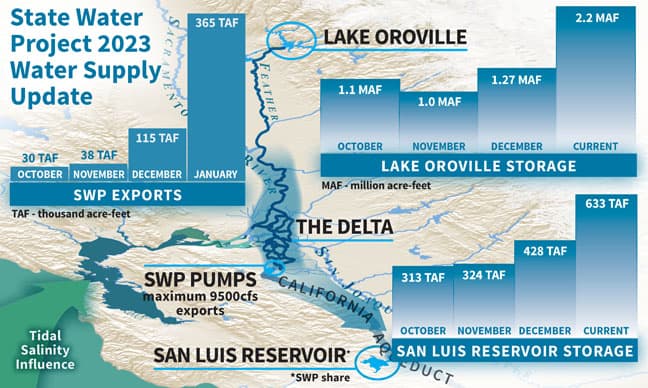Storms may bring relief to drought-stricken state

The California Department of Water Resources announced this week it was increasing its allocation from the State Water Project due to recent storms. The above graphic shows water levels at state reservoirs and the amount of water that is being pumped into the aqueduct. Illustration/courtesy of CDWR
by Steven Felschundneff | steven@claremont-courier.com
A definite silver lining emerged from the destructive storms that pummeled California, when the state’s top water regulator took the first step last week toward easing tough water conservation measures brought on by years of drought.
On Thursday, the California Department of Water Resources announced its intention to boost water allocated to member agencies from the State Water Project, which moves water south from Northern California. The increased supplies will affect 27 million people, most of whom live in Southern California and have been under mandatory water use restrictions since last spring. The announcement is also good news for many of California’s farmers.
The Department of Water Resources now expects to deliver 30% of requested water supplies — 1.27 million acre-feet — in 2023, up from the initial projection of just 5% announced on December 1. The boost in deliveries will affect 29 public water agencies including Three Valleys Municipal Water District, which supplies Claremont.

The California Department of Water Resources announced this week it was increasing its allocation from the State Water Project due to recent storms. The above graphic shows water levels at state reservoirs and the amount of water that is being pumped into the aqueduct. Illustration/courtesy of CDWR
“The allocation increase is the direct result of extreme weather in late December and nine atmospheric rivers in early January that helped fill reservoirs and dramatically increase the Sierra Nevada snowpack,” read a news release from the Department of Water Resources. “The SWP’s two largest reservoirs (Oroville and San Luis) have gained a combined 1.62 million acre-feet of water in storage — roughly enough to provide water to 5.6 million households for a year.”
Last May, the Metropolitan Water District of Southern California declared a water emergency and the Three Valleys’ board responded by implementing a “level five” water contingency plan urging a 50% reduction in water use for areas dependent on the State Water Project. In response, Golden State Water asked its customers in Claremont to cut total water use by 20% and limited outdoor irrigation to once per week.
This fall, the Metropolitan Water District, which serves 19 million people in six counties, warned its customers that another dry winter could result in a total ban on outdoor watering.
“After the three driest years the state has ever seen, we are finally getting some relief. Depleted state reservoirs are starting to recover from record lows, and this increased allocation will certainly help communities hit hardest by this drought recover as well,” Adel Hagekhalil, general manager of the Metropolitan Water District said in a statement. “But make no mistake, while the recent storms will help alleviate the acute emergency in areas dependent on supplies from the State Water Project, Southern California’s water challenges are far from over. We continue to draw down our largest local reservoir, Diamond Valley Lake, to meet demands. Likewise, conditions on our other source of imported supplies, the Colorado River, remain uncertain.”
Also, MWD will continue its efforts to reduce reliance on imported water through its Pure Water Southern Californiarecycling project and by developing new storage capacity throughout the region. Conservation remains a critical tool and MWD encourages all its customers to keep using water as efficiently as possible.
“In no way do these recent storms erode our commitment to continue investing in an equitable and reliable water supply to all of our member agencies. We must be prepared for the next drought, or if dry conditions return in this current one,” Hagekhalil said.
The updated delivery forecast is based on a conservative runoff forecast and current reservoir storage, according to state water officials. It does not include the current Sierra Nevada snowpack, which the Department of Water Resources will monitor monthly through May. The Sierra snowpack is currently at 174% of normal for this date and further allocation updates may occur as that long-term outlook becomes clearer.
“This is super good news, to go from five to 30 percent is hugely important, but we’re not out of woods yet,” said Jeff Hanlon, who represents Claremont and the surrounding area on the Three Valleys Municipal Water District Board of Directors.
Predicting the future is tricky. The state agency will reevaluate reservoir levels in April and make a final determination about the allocation through summer at that time. Our local providers, including Three Valleys and the MWD, will decide in April if the strict conservation measures are still warranted. Hanlon pointed out that we received a fair amount of rain last December and then nothing for three months, which prompted the current water emergency.
Claremonters eager to get back to irrigating their lawns will also have to keep an eye on the snowpack in the Rocky Mountains, because reservoirs along the Colorado River are currently at 20-year low points and if that water system doesn’t get a similar boost, MWD could ask all agencies under its purview to continue with mandatory restrictions.
Bevin Handel, public information officer at the City of Claremont said Golden State Water Company will make its decision about lifting water restrictions on the recommendations from Three Valleys after the Department of Water Resources finalizes the allocations this spring.
“I believe this cautious approach stems from last year’s very wet December followed by the two driest months on record,” Handel said.









0 Comments